Snakes are elongated, legless, carnivorous reptiles of the suborder Serpentes that can be distinguished from legless lizards by their lack of eyelids and external ears. Like all squamates, snakes are ectothermic, amniote vertebrates covered in overlapping scales. Many species of snakes have skulls with several more joints than their lizard ancestors, enabling them to swallow prey much larger than their heads with their highly mobile jaws. To accommodate their narrow bodies, snakes' paired organs appear one in front of the other instead of side by side, and most have only one functional lung. Some species retain a pelvic girdle with a pair of vestigial claws on either side of the cloaca. The largest living snakes in the world, measured either by length or by weight, are various members of the boidae and pythonidae families. They include anacondas, pythons, and boa constrictors, which are all non-venomous constrictors. Here in this article Top 10 Largest Snake in the world written, Read on:
The green anaconda (Eunectes murinus), also known as the common anaconda and water boa, is a non-venomous boa species found in South America. It is the heaviest and one of the longest known extant snake species. The term anaconda often refers to this species, though the term could also apply to other members of the genus Eunectes. They may exceed 227 kg (500 lb), validity questionable 97.5 kg (215 lb) maximum among 780 specimens caught over a seven-year period 1992–1998 Average 30.8 kg (68 lb) among 45 specimens (1992–1998). With an average length of 6 m (20 ft.) and a top length of 8.8 m (29 ft.) the green anaconda is one of the longest snakes in the world. The green anaconda, with a girth of nearly 30 cm (12 in.)
2. The reticulated python (25.2 ft)
The reticulated python (Python reticulatus) is a species of python found in Southeast Asia. It is widely regarded as the world's longest snake and longest reptile, but is not the most heavily built (although it is among the four heaviest). Like all pythons, it is a nonvenomous constrictor and normally not considered dangerous to humans. Although large specimens are powerful enough to kill an adult human, attacks are only occasionally reported. 10 m (33 ft), not firmly verified 7.9 m (26 ft), reasonably reliable, for "Samantha" in 2002, 7.67 m (25.2 ft), somewhat reliable, for "Medusa" in 2011.
3. The African rock python (24 ft)
The African rock python (Python sebae) is a large, nonvenomous snake of sub-Saharan Africa. It is one of 11 living species in the genus Python. It has two subspecies; one is found in Central and Western Africa, the other in Southern Africa. Africa's largest snake and one of the six largest snake species in the world (along with the green anaconda, reticulated python, Burmese python, Indian python, and amethystine python), specimens may approach or exceed 6 m (20 ft)and maximum Length: up to 7.5 m. The snake is found in a variety of habitats, from forests to near deserts, although usually near sources of water. The African rock python kills its prey by constriction and often eats animals up to the size of antelope, occasionally even crocodiles. They can weight Up to 113 kg (250 lb).
4. The Burmese python (22 ft)
The Burmese python (Python bivittatus) is one of the five largest species of snakes in the world (about the third-largest as measured either by length or weight). It is native to a large variation of tropic and subtropic areas of South and Southeast Asia. Until 2009, it was considered a subspecies of Python molurus, but now is recognized as belonging to a distinct species.They are often found near water and are sometimes semi-aquatic, but can also be found in trees. The Burmese python is the largest subspecies of the Indian python, Lengths of more than 15 feet (4.6 m) are common, and they may exceed 22 feet (6.7 m) in captivity, however the average is about 16 feet (4.9 m) in length.
5. The Indian python (21 ft)
The Indian python/Python molurus is a large nonvenomous python species found in many tropic and subtropic areas of South Asia and Southeast Asia. It is known by the common names Indian python, black-tailed python and Indian rock python. The species is limited to Southern Asia. It is generally lighter colored than the Burmese python and reaches usually 3 metres (9.8 ft). Indian pythons, P. molurus molurus, stays smaller, reaching a maximum of about 6.4 m (21 ft) in length, and weighing as much as 91 kg (200 lbs.).
6. The Amethystine scrub python (20 ft)
The Amethystine (scrub) python/Morelia amethistina is a non-venomous species of snake, known as the amethystine, scrub python or Sanca permata locally, found in Indonesia, Papua New Guinea and Australia. Popular among reptile enthusiasts, and noted for its coloration and size, it is one of the six largest snakes in the world, as measured either by length or weight, and is the largest native snake in Australia and Papua New Guinea. Weight up to 90 kg (200 lb) and length In excess of 6 m (20 ft) Typically 3.5 m (11 ft) Minimum adult length 1.8 m (5.9 ft).
7. The Apodora (17 ft)
The Apodora is a monotypic genus created for the non-venomous python species, A. papuana, found in New Guinea. No subspecies are currently recognized. Adults growing to lengths of over 5 m (17 feet). However, they are not nearly as heavy bodied as other pythons, weighing in at no more than about 22.5 kg (50 lb). They are noted for having the ability to change color, though the exact mechanism and reasons for it are not completely understood. The color is reputed to change when the snake is agitated.
8. The yellow anaconda (15.1 ft)
The yellow anaconda (Eunectes notaeus) is a boa species endemic to South America. It is one of the largest snakes in the world, but is not as large as its close relative, the green anaconda. Like all boas and pythons, it is non-venomous and kills its prey by constriction. The yellow anaconda is found in southern regions of South America, including Paraguay, southern Brazil, northeastern Argentina, and Bolivia. They nevertheless grow to an average of 3.3 to 4.4 m (10.8 to 14.4 ft) in total length. They commonly weigh 25 to 35 kg, though large specimens can weigh 40 to 55 kg or even more. The maximum size can certainly be larger, although confusion with its larger cousin may complicate matters. Female yellow anacondas have reportedly been measured up to 4.6 m (15.1 ft).
9. The black mamba (14.8ft)
The black mamba (Dendroaspis polylepis) is a venomous snake endemic to sub-Saharan Africa. It takes its common name not from the color of its scales, but from the interior of its mouth, which is inky-black. It is the longest species of venomous snake on the African continent, with a length typically ranging from 2 meters (6.6 ft) to 3 meters (9.8 ft) and up to 4.3 to 4.5 meters (14.1 to 14.8 ft). It is among the fastest-moving snakes in the world, capable of moving at 11 km/h (6.8 mph) over short distances.
10. The boa constrictor (13 ft)
The boa constrictor or red-tailed boa (Boa constrictor) is a species of large, heavy-bodied snake. It is a member of the family Boidae found in North, Central, and South America, as well as some islands in the Caribbean. A staple of private collections and public displays, its color pattern is highly variable yet distinctive. Ten subspecies are currently recognized, although some of these are controversial. Weights up to More than 45 kg (99 lb), Length Possibly up to 4 m (13 ft).
So What you think about this list don't forget to mention :)
Top 10 Largest Snake in the world
1. The Green anaconda (29 ft.)The green anaconda (Eunectes murinus), also known as the common anaconda and water boa, is a non-venomous boa species found in South America. It is the heaviest and one of the longest known extant snake species. The term anaconda often refers to this species, though the term could also apply to other members of the genus Eunectes. They may exceed 227 kg (500 lb), validity questionable 97.5 kg (215 lb) maximum among 780 specimens caught over a seven-year period 1992–1998 Average 30.8 kg (68 lb) among 45 specimens (1992–1998). With an average length of 6 m (20 ft.) and a top length of 8.8 m (29 ft.) the green anaconda is one of the longest snakes in the world. The green anaconda, with a girth of nearly 30 cm (12 in.)
2. The reticulated python (25.2 ft)
The reticulated python (Python reticulatus) is a species of python found in Southeast Asia. It is widely regarded as the world's longest snake and longest reptile, but is not the most heavily built (although it is among the four heaviest). Like all pythons, it is a nonvenomous constrictor and normally not considered dangerous to humans. Although large specimens are powerful enough to kill an adult human, attacks are only occasionally reported. 10 m (33 ft), not firmly verified 7.9 m (26 ft), reasonably reliable, for "Samantha" in 2002, 7.67 m (25.2 ft), somewhat reliable, for "Medusa" in 2011.
3. The African rock python (24 ft)
The African rock python (Python sebae) is a large, nonvenomous snake of sub-Saharan Africa. It is one of 11 living species in the genus Python. It has two subspecies; one is found in Central and Western Africa, the other in Southern Africa. Africa's largest snake and one of the six largest snake species in the world (along with the green anaconda, reticulated python, Burmese python, Indian python, and amethystine python), specimens may approach or exceed 6 m (20 ft)and maximum Length: up to 7.5 m. The snake is found in a variety of habitats, from forests to near deserts, although usually near sources of water. The African rock python kills its prey by constriction and often eats animals up to the size of antelope, occasionally even crocodiles. They can weight Up to 113 kg (250 lb).
4. The Burmese python (22 ft)
The Burmese python (Python bivittatus) is one of the five largest species of snakes in the world (about the third-largest as measured either by length or weight). It is native to a large variation of tropic and subtropic areas of South and Southeast Asia. Until 2009, it was considered a subspecies of Python molurus, but now is recognized as belonging to a distinct species.They are often found near water and are sometimes semi-aquatic, but can also be found in trees. The Burmese python is the largest subspecies of the Indian python, Lengths of more than 15 feet (4.6 m) are common, and they may exceed 22 feet (6.7 m) in captivity, however the average is about 16 feet (4.9 m) in length.
5. The Indian python (21 ft)
The Indian python/Python molurus is a large nonvenomous python species found in many tropic and subtropic areas of South Asia and Southeast Asia. It is known by the common names Indian python, black-tailed python and Indian rock python. The species is limited to Southern Asia. It is generally lighter colored than the Burmese python and reaches usually 3 metres (9.8 ft). Indian pythons, P. molurus molurus, stays smaller, reaching a maximum of about 6.4 m (21 ft) in length, and weighing as much as 91 kg (200 lbs.).
6. The Amethystine scrub python (20 ft)
The Amethystine (scrub) python/Morelia amethistina is a non-venomous species of snake, known as the amethystine, scrub python or Sanca permata locally, found in Indonesia, Papua New Guinea and Australia. Popular among reptile enthusiasts, and noted for its coloration and size, it is one of the six largest snakes in the world, as measured either by length or weight, and is the largest native snake in Australia and Papua New Guinea. Weight up to 90 kg (200 lb) and length In excess of 6 m (20 ft) Typically 3.5 m (11 ft) Minimum adult length 1.8 m (5.9 ft).
7. The Apodora (17 ft)
The Apodora is a monotypic genus created for the non-venomous python species, A. papuana, found in New Guinea. No subspecies are currently recognized. Adults growing to lengths of over 5 m (17 feet). However, they are not nearly as heavy bodied as other pythons, weighing in at no more than about 22.5 kg (50 lb). They are noted for having the ability to change color, though the exact mechanism and reasons for it are not completely understood. The color is reputed to change when the snake is agitated.
8. The yellow anaconda (15.1 ft)
The yellow anaconda (Eunectes notaeus) is a boa species endemic to South America. It is one of the largest snakes in the world, but is not as large as its close relative, the green anaconda. Like all boas and pythons, it is non-venomous and kills its prey by constriction. The yellow anaconda is found in southern regions of South America, including Paraguay, southern Brazil, northeastern Argentina, and Bolivia. They nevertheless grow to an average of 3.3 to 4.4 m (10.8 to 14.4 ft) in total length. They commonly weigh 25 to 35 kg, though large specimens can weigh 40 to 55 kg or even more. The maximum size can certainly be larger, although confusion with its larger cousin may complicate matters. Female yellow anacondas have reportedly been measured up to 4.6 m (15.1 ft).
9. The black mamba (14.8ft)
The black mamba (Dendroaspis polylepis) is a venomous snake endemic to sub-Saharan Africa. It takes its common name not from the color of its scales, but from the interior of its mouth, which is inky-black. It is the longest species of venomous snake on the African continent, with a length typically ranging from 2 meters (6.6 ft) to 3 meters (9.8 ft) and up to 4.3 to 4.5 meters (14.1 to 14.8 ft). It is among the fastest-moving snakes in the world, capable of moving at 11 km/h (6.8 mph) over short distances.
10. The boa constrictor (13 ft)
The boa constrictor or red-tailed boa (Boa constrictor) is a species of large, heavy-bodied snake. It is a member of the family Boidae found in North, Central, and South America, as well as some islands in the Caribbean. A staple of private collections and public displays, its color pattern is highly variable yet distinctive. Ten subspecies are currently recognized, although some of these are controversial. Weights up to More than 45 kg (99 lb), Length Possibly up to 4 m (13 ft).
So What you think about this list don't forget to mention :)


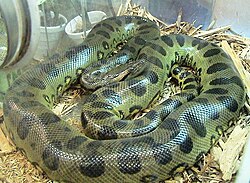
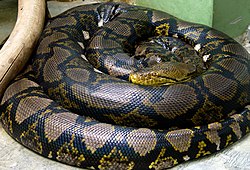
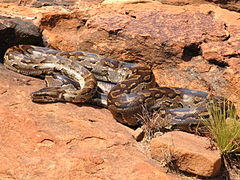

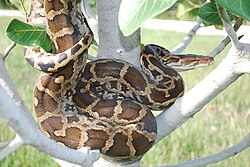
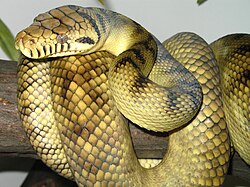


.jpg/220px-Dendroaspis_polylepis_(14).jpg)
.jpg/250px-Boa_constrictor%2C_Va%C5%88kovka%2C_Brno_(2).jpg)










0 comments:
Post a Comment